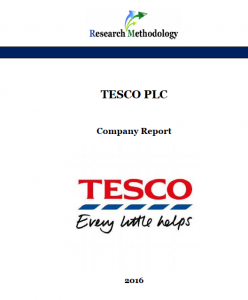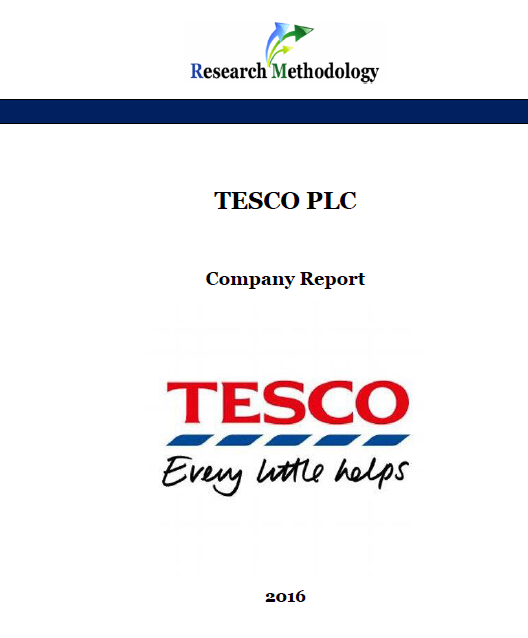Tesco PLC Report

- Published: May 2016
- 9344 Words
- 40 Pages
Tesco PLC is a UK-based global supermarket chain and it has 7817 shops and 517,802 employees around the world. Founded in 1919 by Jack Cohen, Tesco has emerged to become the biggest retailer in the UK and more than 80 million shopping trips are made to Tesco stores each week (Annual Report, 2015). Tesco’s mission statement is “to be the champion for customers – to help everyone who shops with us enjoy a better quality of life and an easier way of living”.
Tesco business strategy can be described as cost leadership with a focus on availability, range and customer service. During the financial year of 2015, the group sales amounted to GBP 69.7 billion with the group trading profit of GBP 1.4 billion, however, the company made a net loss of GBP 6.4 billion during the same period (Annual Report, 2015). Along with market saturation, such a poor financial performance has been caused by a series of scandals that include an overstatement of commercial income by GBP 208 million (Rigby, 2015) and the cases of supplier mistreatment. It has been revealed that the supermarket chain demanded a payment of GBP 1 million from one of its suppliers, L’Oreal (Ahmed, 2015) and the company has been found to delay payment to suppliers in order to improve its operational profit margins in 2014 (Simpson, 2016).
These scandals caused a severe damage to Tesco’s brand image and replacement of the leadership at the top level. The new leadership headed by a new Chairman of the Board John Allan and new CEO Dave Lewis pledged to restore the trust towards the brand via focusing on the core values that had made Tesco popular in the first place.
Tesco PLC Report contains the application of the major analytical strategic frameworks in business studies such as SWOT, PESTEL, Porter’s Five Forces, Value Chain analysis and McKinsey 7S Model on Tesco PLC. Moreover, the report contains analyses of Tesco’s business strategy, leadership and organizational structure and its marketing strategy. The report also discusses the issues of corporate social responsibility.
1. Introduction
2. Business Strategy
3. Leadership
4. Organizational Structure
5. SWOT Analysis
5.1 Strengths
5.2 Weaknesses
5.3 Opportunities
5.4 Threats
6. PESTEL Analysis
6.1 Political Factors
6.2 Economic Factors
6.3 Social Factors
6.4 Technological Factors
6.5 Environmental Factors
6.6 Legal Factors
7. Marketing Strategy
7.1 Marketing Mix
7.2 Segmentation, Targeting & Positioning
7.3 Elements of Tesco Marketing Strategy
7.3.1 Advertising
7.3.2 Sales Promotion
7.3.3 Events & Experiences
7.3.4 Public Relations
7.3.5 Direct Marketing
7.3.6 Personal Selling
8. Porter’s Five Forces Analysis
9. Value-Chain Analysis
9.1 Primary Activities
9.2 Support Activities
10. McKinsey 7S Framework
11. Corporate Social Responsibility (CSR)
11.1 CSR Programs and Initiatives
11.2 CSR Criticism
12. Recommendations
List of Figures
Figure 1 Tesco Corporate Governance Structure
Figure 2 Tesco organizational structure at store level
Figure 3 Changes in Tesco’s profit before tax
Figure 4 Changes in the number of Tesco stores worldwide
Figure 5 Changes in Tesco advertising budget
Figure 6 Tesco Porter’s Five Forces
Figure 7 Market share of grocery retail chains in the UK from January 2015 to April 2016 27
Figure 8 Tesco Value Chain Analysis
Figure 9 Tesco McKinsey 7S Framework
List of Tables
Table 1 Tesco SWOT analysis
Table 2 Tesco segmentation, targeting and positioning for Technika TV
Table 3 Tesco CSR performance
ALDI
ASDA
BBC
Blinkbox
British Heart Foundation
Iceland
Lidl
Lloyds Banking Group
Morrisons
Sainsbury’s
Tesco PLC
The Cooperative
Unilever
Waitrose
Walmart
Why this report is so cheap?
1. Reports offered in this portal are produced by a small group of academic writers headed by John Dudovski.
2. Our reports are shorter compared to reports produced by large research companies. Company reports are produced to assist with academic works of business students in particular. Therefore, all points that do not relate to academic needs of business students are left out.
3. We do not have huge fixed expenses large research companies do, thus, we are able to deliver reports for a little cost.
How do I receive the report?
After completing the payment you will receive a link to the e-mail related to your Pay Pal account or the e-email you entered when specifying bank details. You can download the report via this link. The report is downloaded in PDF format. The link will stay active for 7 days.
How can I use the report to complete my academic assignment/research?
Reports offered by research-methodology.net are professionally written samples in their respective areas. Reports are intended to be used as guides and sources of secondary data for reference purposes.
I did not receive the link/I can not download the report?
If you have any difficulties with downloading reports you have purchased please e-mail us the details of your purchase. We will send the report to you as an e-mail attachment shortly.
- Published: May 2016
- 9344 Words
- 40 Pages




